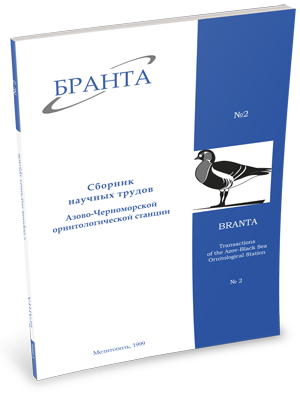
Transactions
of the Azov-Black Sea Ornithological Station



Feeding ecology and time budgets of Сurlew Sandpiper and Dunlin during spring stopover in the Sivash, Ukraine
Khomenko S.V., Garmash В.А., Metzner J., Nickel M.
The study localities were Dzhankoi Bay and village Tselinnoe (fig.1.) covered by parallel counts and observations over the period 1 to 27 May 1996. Bird distribution within study areas and their migration number dynamics were analyzed, as well as compared feeding time budget in day hours at the brackish bay (SE-41, рис. 1) of Eastern Sivash (SU) and in hypersaline waters of Central Sivash (SC) (SC-20 and 22, fig. 1).
In the latter case it was registered intensity of taking the main prey, artemia. Curlew Sandpipers demonstrated strong selectivity regarding to hypersaline areas, and Dunlins showed less but still significant selectivity regarding to brackish areas. Terms of reaching maximum numbers by Dunlins (Table 1) 4-5 days outran those of Curlew Sandpipers: 1st wave – 3-4 May (8-9 May for Curlew Sandpiper), 2nd wave – 18 May (22 May for Curlew Sandpiper). Feeding time budget of Curlew Sandpipers were significantly higher at SC (79.4±22.3) compared with SE (74.5±23.8). Even more differences were revealed for Dunlins (SC – 75.5±24.9; SE -47.1±36.0). This index did not differ between species at SC but sharply contrasted at SE that is explained by possible night feeding of Dunlins on nereis in the brackish bay. Under equal conditions both species preferred day feeding (Fig.2).
Feeding time budget at SC is well consistent with general migration dynamics of each of these species, while at SC they more correspond to the Dunlin’s terms of passage (Table 4, Figure 5).
Artemia intake rate was dependent on its abundance. Mean pecking rate of Curlew Sandpipers were higher, especially under low numbers of artemia. This wader species tended to intensifying feeding during day hours which was not recorded for the Dunlin. Aggregations of waders at SC demonstrated high mobility connected with redistribution of artemia. Though their night roosting sites were permanent, birds every day moved along the shoreline looking for optimal feeding conditions. Comparison of energy expenditure (1.8-1.9 BMR) and energy intake (3.2-3.3 BMR) when feeding on artemia (Table 6) showed capacity of birds to gain body mass with the rate 3.6 to 5.6 g/day (Curlew Sandpiper – 4.3±1.1 g/day, Dunlin – 3.8±0.4 g/day).
Given the duration of stopovers (5-6 days), it ensures that Curlew Sandpipers can gain body mass sufficient for a 2000-2500 km non-stop flight. For Dunlins this distance is presumably even bigger, though additional research is required. During Sivash stopovers, a majority of Curlew Sandpipers rely on artemia which is common but rather unpredictable prey, available only in day hours. That is why the Curlew Sandpipers concentrate there for a short period in the first half of May. Under favourable feeding conditions, they use all day hours for feeding and then can flight to the next area on their migration route. And if feeding conditions are unfavourable, they still have time to correct the route, destination and terms of their migration.
Dunlins show high lability in feeding conditions. They are able to use both plankton and benthos prey, and to feed day and night. Depending on wind direction, they concentrate in brackish of hypersaline areas and frequently change their location within Sivash. Therefore, the stopovers of Dunlins are longer and there is a high probability that they can depart Sivash to flight directly to their breeding grounds.
Read the paper in a PDF file